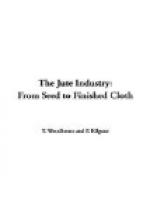Some of the stricks of fibre are seen distinctly on the feed side of the figure; they are accommodated, as mentioned, in a channel-shaped stand on the far side of the inclined feed sheet, or feed cloth, which leads up to and conveys the stricks into the grip of the feeding apparatus. This particular type is termed a “shell” feed because the upper contour of the guiding feed bracket is shaped somewhat like a shell. There is a gradually decreasing and suitably-sized gap between the upper part of the shell and the pins of the feed roller.
The root ends of the pins in this roller lead, and the stricks of fibre are gripped between the pins and the shell, and simultaneously carried into the machine where they come into contact with the points of the pins in the rapidly-revolving large roller, termed a cylinder. The above-mentioned combing and splitting action takes place at this point as well as for a distance of, say, 24 inches to 30 inches below. The fibres which are separated at this stage are carried a little further round until they come into contact with the points of the pins in the above-mentioned slowly-moving roller, termed a “worker,” and while the fibres are moving slowly forward under the restraining influence of the worker, they are further combed and split. A portion of the fibres is carried round by the pins of the worker from which such fibres are removed by the quicker moving pins of the second roller of the pair, termed a “stripper,” and in turn these fibres are removed from the pins of the stripper by the much quicker moving pins of the cylinder.
[Illustration: FIG. 14 MODERN BREAKER CARD]
The above operations conducted by the first pair of rollers (worker and stripper) in conjunction with the cylinder, are repeated by a second and similar pair of rollers (worker and stripper), and ultimately the thin sheet of combed and split fibres comes into contact with the pins of the doffer from which it is removed by the drawing and pressing rollers. The sheet of fibres finally emerges from these rollers into the broad and upper part of the conductor. This conductor, made mostly of tin and V-shaped, is shown clearly on the left of the machine in Fig. 14. Immediately the thin film or sheet of fibres enters the conductor, it is caused as a body gradually to contract in width and, of course, to increase in thickness, and is simultaneously guided and delivered to the delivery rollers, and from these to the sliver can, distinctly seen immediately below the delivery rollers. The sliver is seen emerging from the above rollers and entering the sliver can.
The fibres in this machine are thus combed, split and drawn forward relatively to each other, in addition to being arranged more or less parallel to each other. The technical term “draft” is used to indicate the operation of causing the fibres to slip on each other, and in future we shall speak about this attenuation or drawing out of the fibres by this special term “draft.”




